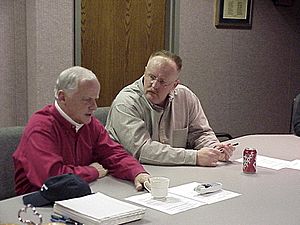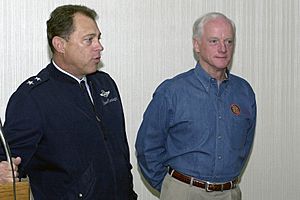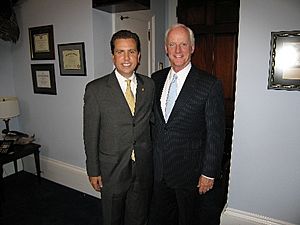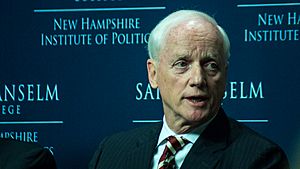Frank Keating facts for kids
Quick facts for kids
Frank Keating
|
|
|---|---|

Keating in 2001
|
|
| 25th Governor of Oklahoma | |
| In office January 9, 1995 – January 13, 2003 |
|
| Lieutenant | Mary Fallin |
| Preceded by | David Walters |
| Succeeded by | Brad Henry |
| United States Deputy Secretary of Housing and Urban Development | |
| In office 1992–1993 |
|
| President | George H. W. Bush |
| Preceded by | Alfred A. DelliBovi |
| Succeeded by | Terrence R. Duvernay |
| United States Associate Attorney General | |
| In office 1988–1990 |
|
| President | Ronald Reagan George H. W. Bush |
| Preceded by | Stephen S. Trott |
| Succeeded by | Wayne Budd |
| United States Attorney for the Northern District of Oklahoma | |
| In office 1981–1983 |
|
| President | Ronald Reagan |
| Preceded by | Hubert H. Bryant |
| Succeeded by | Layn R. Phillips |
| Member of the Oklahoma Senate from the 38th district |
|
| In office 1975–1981 |
|
| Preceded by | Peyton A. Breckinridge |
| Succeeded by | Wayne Winn |
| Member of the Oklahoma House of Representatives from the 70th district |
|
| In office 1973–1975 |
|
| Preceded by | Richard Hancock |
| Succeeded by | Paul Brunton |
| Personal details | |
| Born |
David Rowland Keating
February 10, 1944 St. Louis, Missouri, U.S. |
| Political party | Republican |
| Spouse |
Catherine Heller
(m. 1972) |
| Children | 3, including Chip Keating |
| Education | |
Frank Keating (born February 10, 1944) is an American lawyer, politician, and former FBI special agent. He served as the 25th Governor of Oklahoma from 1995 to 2003.
He is one of only five governors in Oklahoma history to serve two terms in a row. He was also the first Republican to do this. As governor, he led the state's response to the Oklahoma City bombing. His time in office also included changes to welfare programs and tax cuts.
Contents
Early Life and Education
Frank Keating was born on February 10, 1944, in St. Louis, Missouri. His birth name was David Rowland Keating, but it was changed when he was two years old. Before he was six months old, his family moved to Oklahoma and settled in Tulsa.
He went to Cascia Hall Preparatory School in Tulsa and graduated in 1962. Keating then attended Georgetown University in Washington, D.C.. He was president of the student body there and earned a degree in history in 1966. In 1969, he received his law degree from the University of Oklahoma College of Law. He was also student body president there.
After law school, Keating became a Special agent for the Federal Bureau of Investigation (FBI). He worked on the West Coast, investigating different incidents. Later, he returned to Tulsa to work as an assistant district attorney.
In 1973, Keating was elected to the Oklahoma House of Representatives. He served one term there until 1975. Then, he was elected to the Oklahoma Senate, where he served from 1975 to 1981. While in the Senate, he became the minority leader.
Federal Government Career
Because of his background in law enforcement and his role in the Oklahoma Republican Party, President Ronald Reagan chose Keating for an important job. He became the U.S. Attorney for the Northern District of Oklahoma in 1981. He held this position until 1983. During this time, he also led all U.S. Attorneys for a period.
After Reagan's second term began, he appointed Keating as an assistant secretary of the Treasury. Later, he became the associate attorney general, which is the third-highest position in the U.S. Department of Justice. These roles made Keating the highest-ranking Oklahoman in the Reagan administration. He oversaw law enforcement agencies within both the Justice and Treasury departments.
In 1990, President George H. W. Bush appointed Keating to a high position in the Department of Housing and Urban Development. He served as general counsel and acting deputy secretary until 1993. He was again the highest-ranking Oklahoman in the federal government under President Bush.
Running for Governor
1994 Election
After working in private life for two years, Keating ran for Governor of Oklahoma in 1994. He won the Republican nomination. In a three-way race, he was elected as the 25th Governor of Oklahoma on January 9, 1995. He was only the third Republican to hold this position.
1998 Re-election
Keating ran for re-election in 1998. He won by a large margin, becoming the second governor in Oklahoma history to win two terms in a row. He was the only Republican to do so until Mary Fallin in 2014.
Governor of Oklahoma
| The Cabinet of Governor Frank Keating (1995–2003) | |||
|---|---|---|---|
| Office | Name | Term | |
| Governor | Frank Keating | 1995–2003 | |
| Lieutenant Governor | Mary Fallin | 1995–2003 | |
| Secretary of State | Tom Cole | 1995–1999 | |
| Michael J. Hunter | 1999–2002 | ||
| Kay Dudley | 2002–2003 | ||
| Attorney General | Drew Edmondson | 1995–2003 | |
| State Auditor and Inspector | Clifton Scott | 1995–2003 | |
| State Treasurer | Robert Butkin | 1995–2003 | |
| Insurance Commissioner | John Crawford | 1995–1999 | |
| Carroll Fisher | 1999–2003 | ||
| Labor Commissioner | Brenda Reneau | 1995–2003 | |
| Superintendent of Public Instruction | Sandy Garrett | 1995–2003 | |
| Secretary of Administration | Tom Brennan | 1995–1997 | |
| Pam Warren | 1997–2003 | ||
| Secretary of Agriculture | Dennis Howard | 1995–2003 | |
| Secretary of Commerce | Dean Werries | 1995–1997 | |
| Ron Rosenfeld | 1997–1998 | ||
| Howard Barnett Jr. | 1998–1999 | ||
| Russell M. Perry | 1999–2000 | ||
| Vacant | 2000–2003 | ||
| Secretary of Education | Floyd Coppedge | 1995–2003 | |
| Secretary of Energy | Carl Michael Smith | 1995–2002 | |
| Robert J. Sullivan Jr. | 2002–2003 | ||
| Secretary of the Environment | Gary Sherrer | 1995–1997 | |
| Brian C. Griffin | 1997–2003 | ||
| Secretary of Finance and Revenue | Tom Daxon | 1995–2003 | |
| Secretary of Health and Human Services | Ken Lackey | 1995–1997 | |
| Jerry Regier | 1997–2002 | ||
| Howard Hendrick | 2002–2003 | ||
| Secretary of Human Resources | Oscar B. Jackson Jr. | 1995–2003 | |
| Secretary of the Military | Stephen Cortright | 1995–2003 | |
| Secretary of Safety and Security | Robert Ricks | 1995–2003 | |
| Secretary of Science and Technology | W. Arthur Porter | 1999–2003 | |
| Secretary of Tourism and Recreation | Edward H. Cook | 1995–1999 | |
| Jane Jayroe | 1999–2003 | ||
| Secretary of Transportation | Neal A. McCaleb | 1995–2001 | |
| Herschal Crow | 2001–2003 | ||
| Secretary of Veterans Affairs | Norman Lamb | 1995–2003 | |
Oklahoma City Bombing Response
Just three months after he became governor, on April 19, 1995, the Alfred P. Murrah Federal Building in Oklahoma City was destroyed. This event, known as the Oklahoma City bombing, caused the loss of 168 lives and injured over 800 people. Many buildings nearby were also damaged, leaving people without homes and closing businesses.
Governor Keating quickly organized relief and rescue teams. More than 12,000 people helped with rescue efforts in the days after the explosion. People from all over the country and the world offered help. Governor Keating declared a state of emergency. This allowed the Federal Emergency Management Agency (FEMA) to send special search and rescue teams.
President Bill Clinton, Governor Keating, and Reverend Billy Graham spoke in Oklahoma City on April 23. In the weeks that followed, rescue efforts ended, and the damaged building was taken down. Governor Keating and his wife, Cathy Keating, received national and international attention for their work to help the victims and their families. Governor Keating also created a $6 million fund to help victims and provide college scholarships for children who lost a parent in the attack.
First Term Achievements
Governor Keating had many goals for Oklahoma during his time in office. Many of his ideas were approved, even though the Legislature was often controlled by the Democratic Party. His proposals aimed to help Oklahoma grow and improve. These included changes to education, protecting the environment, tax relief, building roads, and improving public safety.
One of Keating's first big successes was passing the first welfare reform law in the nation in 1995. This law became a model for a similar national law passed by President Clinton in 1996. Keating also improved roads and highways across the state without raising taxes.
He made changes to parole policies and introduced new laws about sentencing. Keating also increased the salaries of Oklahoma's state troopers. He appointed a special group to create stronger rules for Oklahoma's hog and poultry farms.
In 1998, Keating was the first governor in 50 years to achieve a cut in the state's income tax. This, along with other tax reductions, was the largest tax break in Oklahoma's history at that time.
Second Term Goals and Actions

Keating's second term began on January 11, 1999, with a focus on education. In his speech, he set four main goals for Oklahoma:
- Raise Oklahoma's ACT scores to the national average by 2005.
- Lower Oklahoma's divorce rate by 50% before 2010.
- Ensure one out of every three Oklahomans has a college degree by 2010.
- Increase Oklahoma's per capita income to reach the national average by 2025.
He greatly increased spending for schools and colleges across the state. He also brought charter schools to Oklahoma for the first time. His education policies led to the largest investment in higher education, over $100 million. In 2000, Keating also raised teacher pay by over $3000 annually, which was the biggest raise Oklahoma teachers had ever received. He also worked to attract more higher education facilities to Tulsa.
Keating also worked to reduce taxes further. He helped pass an income tax break and created Oklahoma's earned income credit system to help those with lower incomes.
Among his other achievements, Keating oversaw the largest road construction project in Oklahoma's history. He also led the state through severe tornadoes in 1999. A major accomplishment was raising over $20 million in private money to complete the Oklahoma State Capitol with a dome. The capitol building was designed to have a dome, but funding ran out during World War I.
Term limits meant he could not run for a third term. He was succeeded by Brad Henry as governor.
Post-Governorship Activities
After his time as governor, Frank Keating wrote several children's books. These included books about Oklahoma humorist Will Rogers (2002), Theodore Roosevelt (2006), and George Washington (2012). He also served on the boards of important organizations like the National Archives and Mt. Vernon. He lives in McLean, Virginia.
Keating and his wife, Cathy, have three children: Carrie, Kelly, and Chip.
In 2007, Keating decided not to run for president in the 2008 election. He later supported John McCain's campaign.
After his governorship, Keating became president and CEO of the American Council of Life Insurers. This group represents the life insurance and retirement security industry. Later, on January 1, 2011, he became president and CEO of the American Bankers Association. This organization represents banks of all sizes across the nation.
Keating also worked on the Debt Reduction Task Force and Housing Commission at the Bipartisan Policy Center. In 2013, he supported a bill for comprehensive immigration reform. In 2016, Keating joined the law firm of Holland & Knight. In 2017, he was nominated to serve on the University of Oklahoma Board of Regents.
See also
- George H. W. Bush judicial appointment controversies
- Keating v. Edmondson
- 47th Oklahoma Legislature
- 48th Oklahoma Legislature




